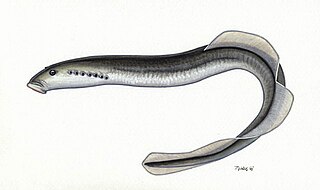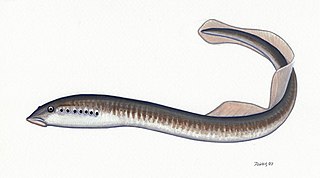
Petromyzontidae are a family of lampreys native to the Northern Hemisphere, comprising the vast majority of living lampreys. Petromyzontids have the highest number of chromosomes (164–174) among vertebrates.

The European river lamprey, also known as the river lamprey or lampern, is a species of freshwater lamprey.

The chestnut lamprey is a species of lamprey.
The silver lamprey is a lamprey commonly found in the Northern and Central United States, as well as a large part of southern Canada. Its binomial name means "sucking fish" in Greek and "one-pointed" in Latin. The silver lamprey is a member of the class Agnatha, sometimes referred to as cyclostomes (round-mouths). Other common names include: bloodsucker, blue lamprey, hitch-hiker, lamper, lamprey eel, northern lamprety. The silver lamprey should not be confused with the sea lamprey, which has caused considerable damage to native fish populations in the Great Lakes region.
The mountain brook lamprey or Allegheny brook lamprey is a lamprey found in parts of the Mississippi river basin, New York, Pennsylvania, Ohio, and in the Cumberland River and Tennessee River. This fish is jawless with a small sucker mouth and a long, eel-like body. It is fairly small, only growing to about 8 inches (20 cm) in length.

Mordacia is a genus of lamprey, the sole genus of the family Mordaciidae, also known as the southern topeyed lampreys.
The southern brook lamprey is a lamprey found in the Southern United States including Arkansas, Louisiana, Mississippi, Alabama, and Georgia. It is a jawless fish with a sucking mouth on one end of it. It can appear to be a small eel, since it is rarely longer than one foot in length.

The northern brook lamprey is a freshwater fish in the family Petromyzontidae. It is closely related to the silver lamprey and may represent an ecotype of a single species with I. unicuspis.

Eudontomyzon danfordi, the Carpathian brook lamprey or Danube lamprey, is a species of lamprey in the family Petromyzontidae. It is found in Austria, Bosnia and Herzegovina, Bulgaria, Croatia, Czech Republic, Hungary, Moldova, Romania, Serbia, Montenegro, Slovakia, and Ukraine. Unlike other brook lampreys, this fish is parasitic.

Eudontomyzon is a genus of lamprey in the family Petromyzontidae. Most species are found in Eastern Europe.
The Greek lamprey is a species of jawless fish in the Petromyzontidae family. It is endemic to Greece. Its natural habitats are rivers and freshwater springs. It is threatened by habitat loss. This species may be better included in the genus Caspiomyzon. It is the most endangered species of lamprey. It lives only in the Strymon and Louros river basins.

The Ukrainian brook lamprey is a species of lamprey in the Petromyzontidae family. It is found in brackish and freshwater areas in Austria, Belarus, Bulgaria, the Czech Republic, Georgia, Hungary, Moldova, North Macedonia, Poland, Romania, Russia, Serbia and Montenegro, Slovakia, Turkey, and Ukraine. It invaded the basin of the Volga River in 2001.
The Kern brook lamprey is a species of lamprey in the Petromyzontidae family endemic to the United States. It is found on the east side of San Joaquin Valley, in lower Merced, Kaweah, Kings, and San Joaquin rivers in California. It can grow to up to around 14 centimeters, and is characterized by its grayish brown and white coloring, and black spots on its fins.

Lampetra is a genus of lampreys in the family Petromyzontidae.

Lethenteron is a genus of lamprey in the family Petromyzontidae.

Lampreys are an ancient lineage of jawless fish of the order Petromyzontiformes. The adult lamprey are characterized by a toothed, funnel-like sucking mouth. The common name "lamprey" is probably derived from Latin lampetra, which may mean "stone licker", though the etymology is uncertain. Lamprey is sometimes seen for the plural form.
Caspiomyzon is a genus of lamprey in the family Petromyzontidae. They are native to Eastern Europe and parts of Western and Central Asia. Two of the three species in the genus are endemic to Greece.
The Ohio lamprey is a lamprey found in the Ohio River drainage basin in the United States and is a parasitic species of lampreys. They are considered to be an endangered/rare species in some states, due to siltation, pollution, and construction of dams.
Entosphenus is a genus of lampreys.










